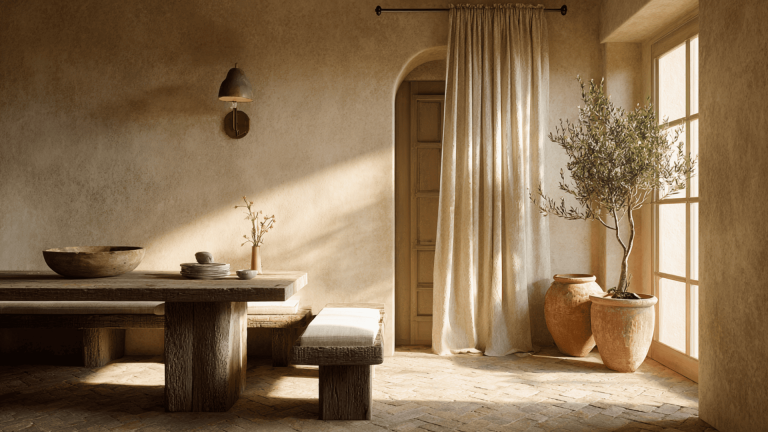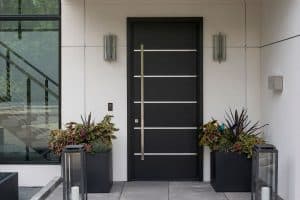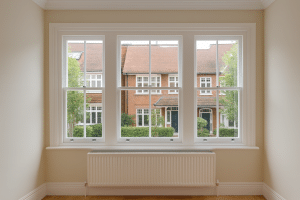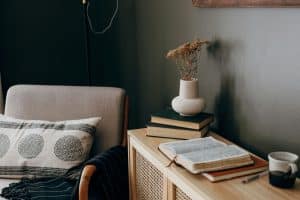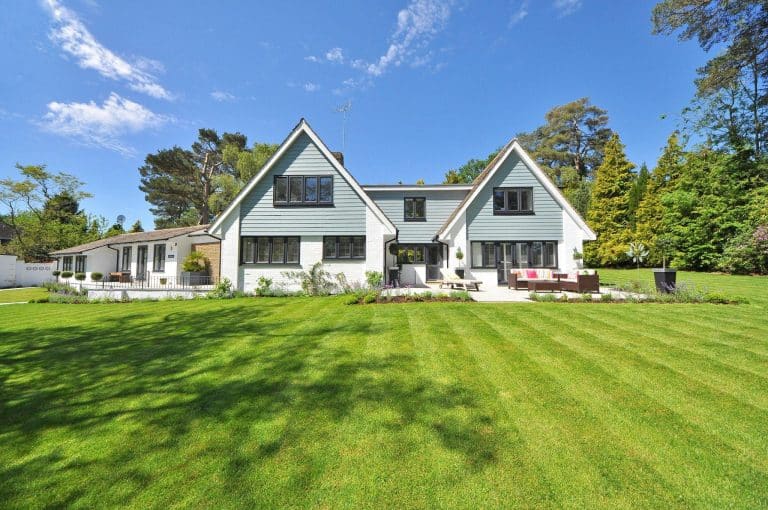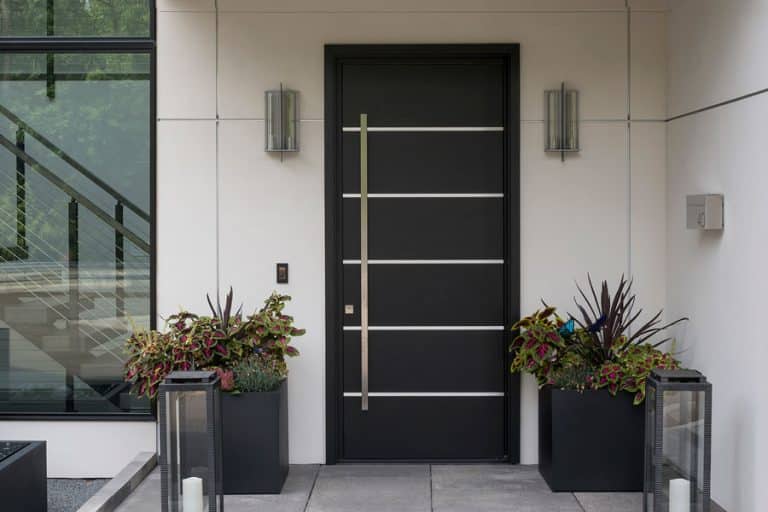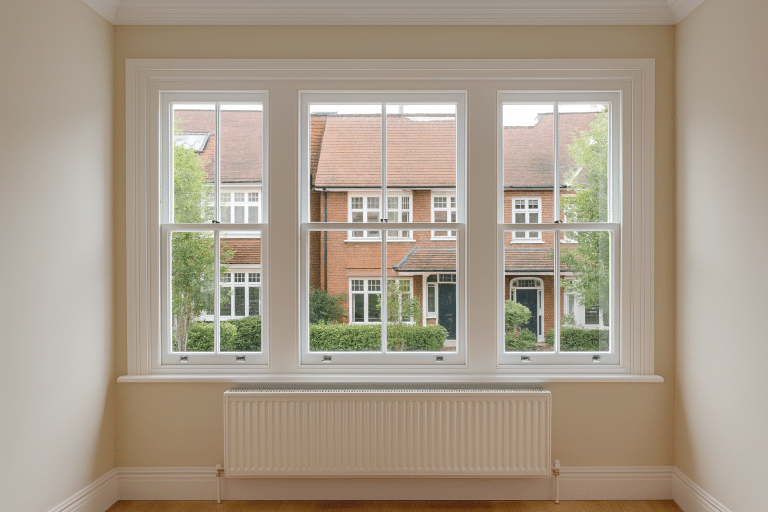If you want your home to feel warm and lived-in, a Tuscan house interior could be just right. This style mixes cozy comfort, natural textures, and a classic look without feeling stiff or overdone.
Bring in an indoor olive tree or terracotta pots of rosemary to add fresh greenery and raise that earthy, relaxed vibe.
I’ll guide you room by room so you can bring that Tuscan warmth into your own space. If you’re starting from scratch or just updating a few pieces, I’ll explain why this look works, how to mix in modern elements, and what to shop for.
By the end, you’ll have simple, practical ideas to craft a grounded, inviting home that feels completely yours.
What is Tuscan House Interior Design?
You can trace Tuscan decor back to Italy’s countryside. Picture rolling hills, sturdy stone farmhouses, and rooms built to last.
It leans on natural materials and old-world building methods. It doesn’t feel fancy, just solid, warm, and full of style.
Where the Style Comes From
Tuscan decor started in the countryside of Italy. Think rolling hills, stone farmhouses, and rooms built to last.
It pulls in a lot from nature and traditional building styles. Nothing feels fancy, just solid, warm, and full of charm.
What Makes It Feel Tuscan
When you step into a Tuscan-style space, certain details always catch your eye. You might’ve seen them too:
- Earthy colors like olive green, burnt orange, and soft gold
- Real materials, wood beams, stone floors, and iron light fixtures
- Textures that feel rough and natural, like stucco walls or linen curtains
- Arched doorways and old-style windows
- Furniture that looks worn in, not worn out
It’s the kind of design that feels like it has stories to tell.
How It’s Different from Similar Styles
It’s easy to mix up Tuscan, Mediterranean, and French Country styles. They share some traits, but here’s how I spot the differences:
| Style | Colors | Materials | Vibe |
|---|---|---|---|
| Tuscan | Warm, earthy | Stone, wood, terracotta | Rustic and grounded |
| Mediterranean | White, blue, tan | Tile, stucco, iron | Bright and breezy |
| French Country | Soft pastels | Wood, linen, lace | Delicate and cozy |
If you want something warm and full of character, Tuscan might be the way to go. I’ve always liked how it mixes old and comfortable in the best way.
Core Elements of Tuscan Interior Design
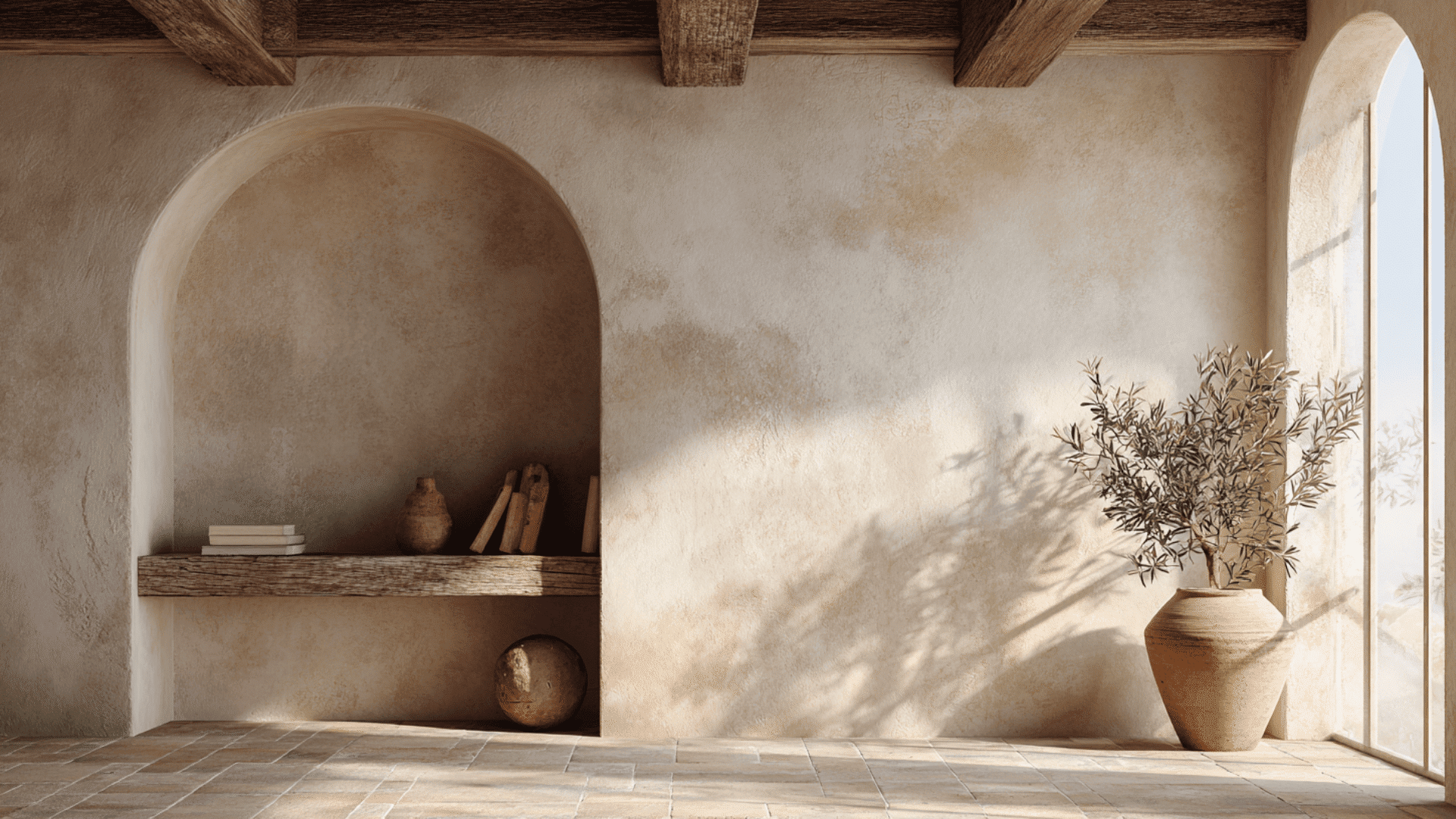
When I think about what makes a space feel Tuscan, it comes down to simple elements. You don’t need a big budget or a villa, just the right colors, textures, and materials. Let’s walk through them so you can shape your own grounded space.
Color Palette
Tuscan interiors lean on colors that feel warm and drawn from nature. I’ve found shades like terracotta, olive green, and burnt sienna instantly give a room that cozy, earthy mood.
You’ll also spot golden yellows, soft browns, and creamy beige colors that echo the Tuscan countryside. If you’re picking paint or decor, lean into those tones. They help the space feel lived-in, inviting, and full of life.
Natural Materials and Textures
This style leans into materials that feel honest and solid. You’ll see stone floors, rustic wood beams, and textured walls. In my own work, I’ve used linen curtains and iron light fixtures to bring in that raw, handmade feel.
Even small updates, like swapping in rough fabrics or placing a stone planter, can give your space a more authentic Tuscan vibe.
Architectural Details
One of the easiest ways to spot a Tuscan-style home is by its old-world hints. Arched doorways and windows stand out right away. You’ll also notice exposed wood beams, brick fireplaces, or rough-textured walls.
Even if your home doesn’t come with those features, you can still get the look. I’ve seen folks use faux beams or paint techniques to mimic them, and they work better than you’d think.
Tuscan design isn’t about being perfect. It’s about warmth, history, and texture. And the best part? You can bring all of that into your space, one simple detail at a time.
Tuscan Interior Room-by-Room Inspo
Every room in a Tuscan-style home has its own feel, but they all stay tied together through warmth and comfort. I’ll walk you through how to bring that same feel into each space, based on what I’ve seen work and tried myself.
Tuscan Kitchen
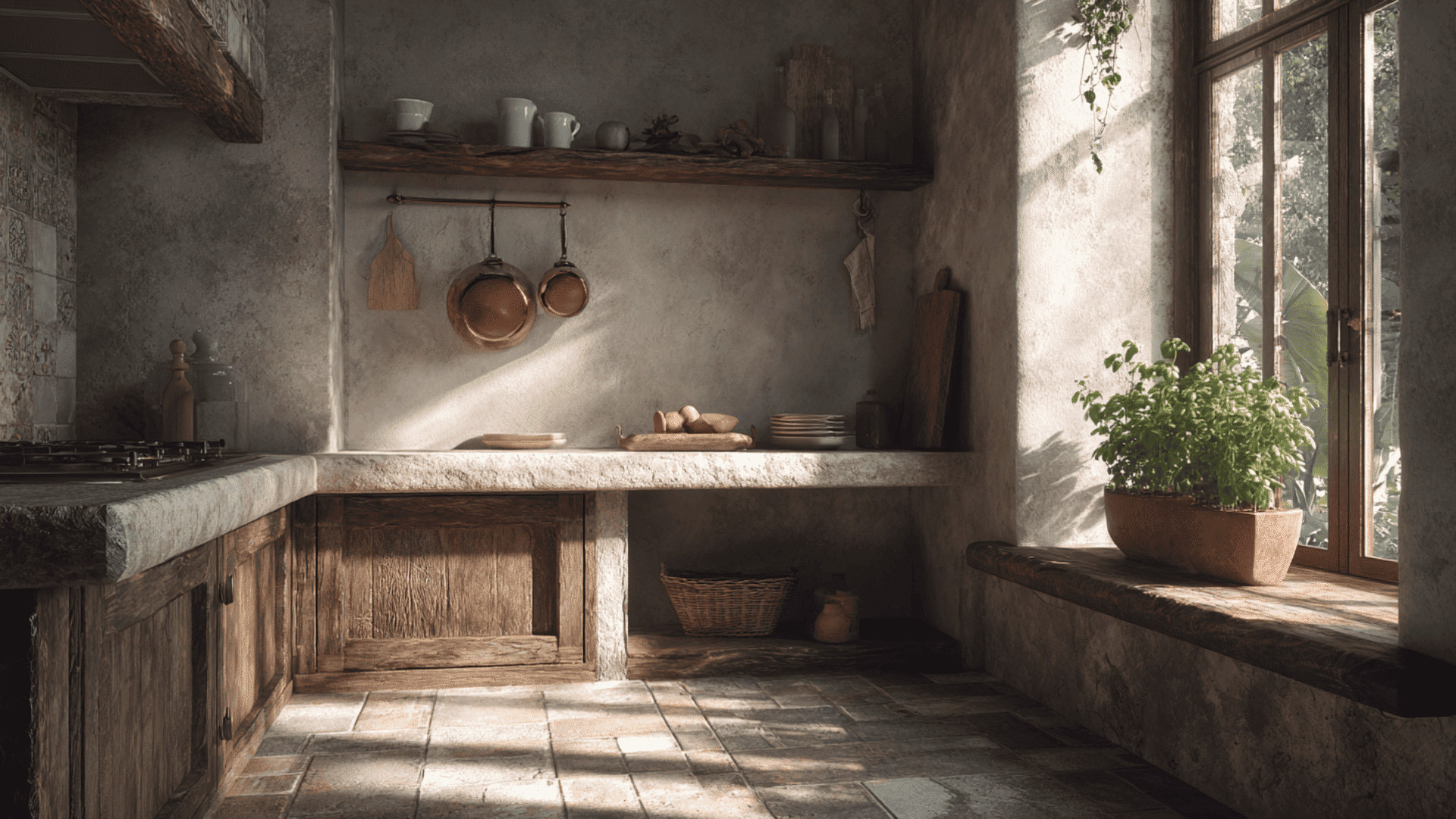
The kitchen is the heart of a Tuscan home. It’s warm, a little rustic, and built to be used, not just admired. You’ll see heavy wood cabinets, stone or tile floors, and open shelves with simple, well-loved dishes on display.
I like bringing in copper pots or ceramic bowls that work as decor and tools. If your kitchen feels too modern, adding a wooden island or a few rustic pieces can shift the whole mood.
Tuscan Living Room
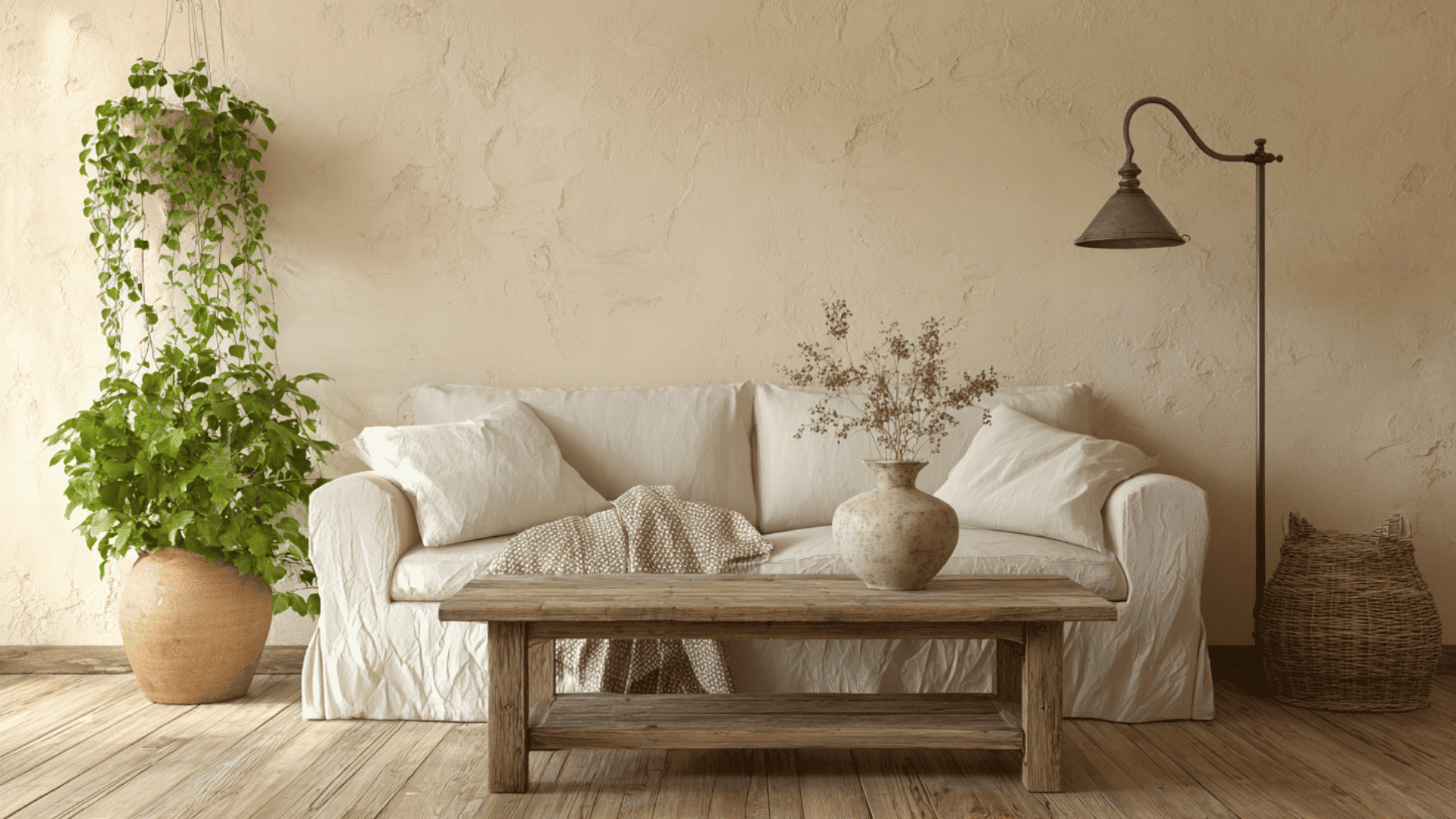
A Tuscan living room feels like a spot made for real comfort. The furniture’s big and soft, often covered in worn leather or thick fabric that holds up over time.
I’ve found that layered textures, like a linen throw or a weathered coffee table, go a long way in making the room feel inviting.
Warm lighting makes a big difference, too. Skip the bright overhead lights and use lamps or sconces with a soft, cozy glow.
Tuscan Bathroom
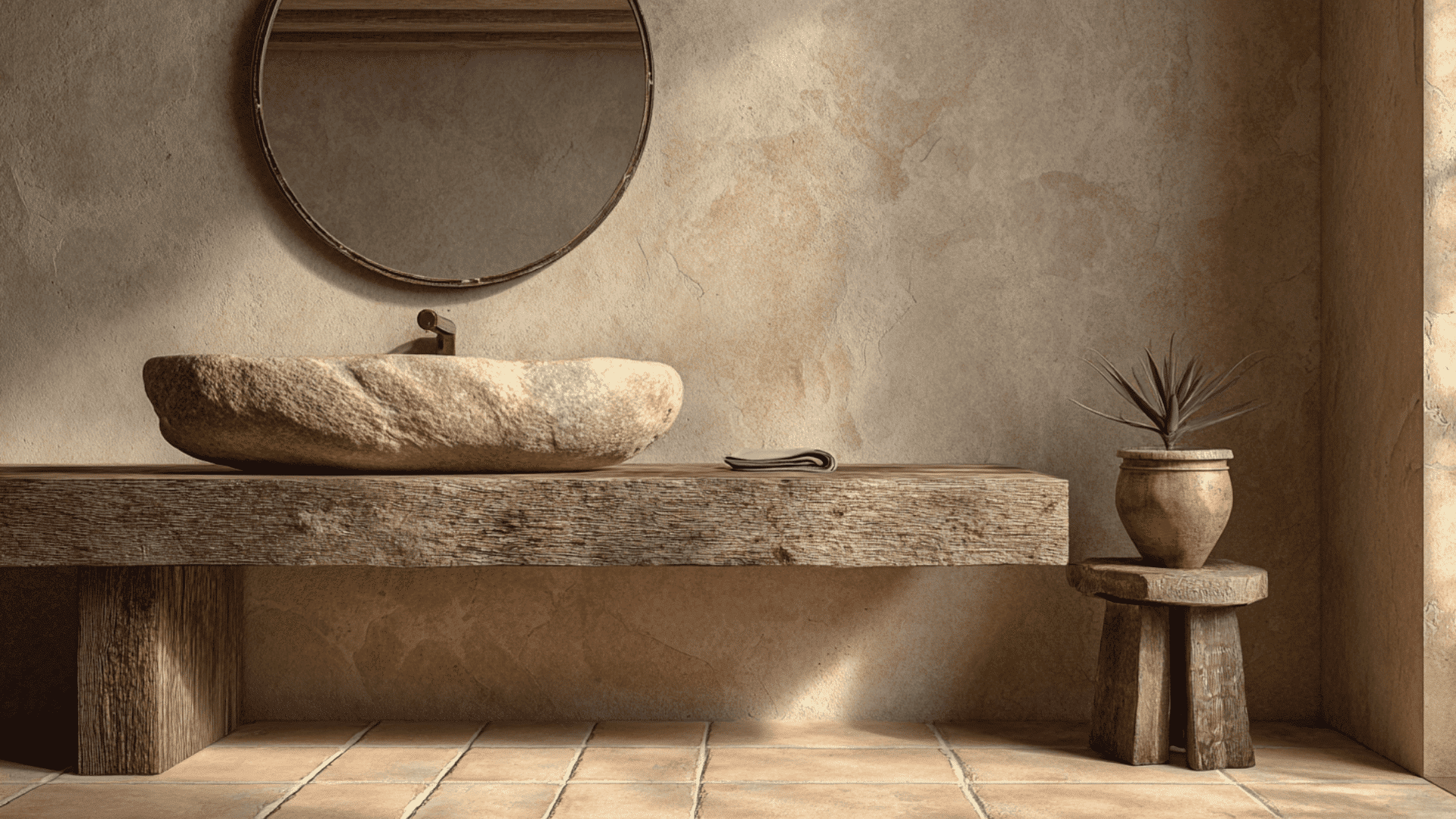
Even bathrooms can carry that Tuscan feel. I’ve seen great setups with stone sinks, terracotta floors, and mirrors that look like antiques.
You don’t need a full remodel to get there. Just swap out the hardware, use earthy paint tones, or bring in natural textures like wood or woven baskets to give the space that rustic look.
Tuscan Bedroom
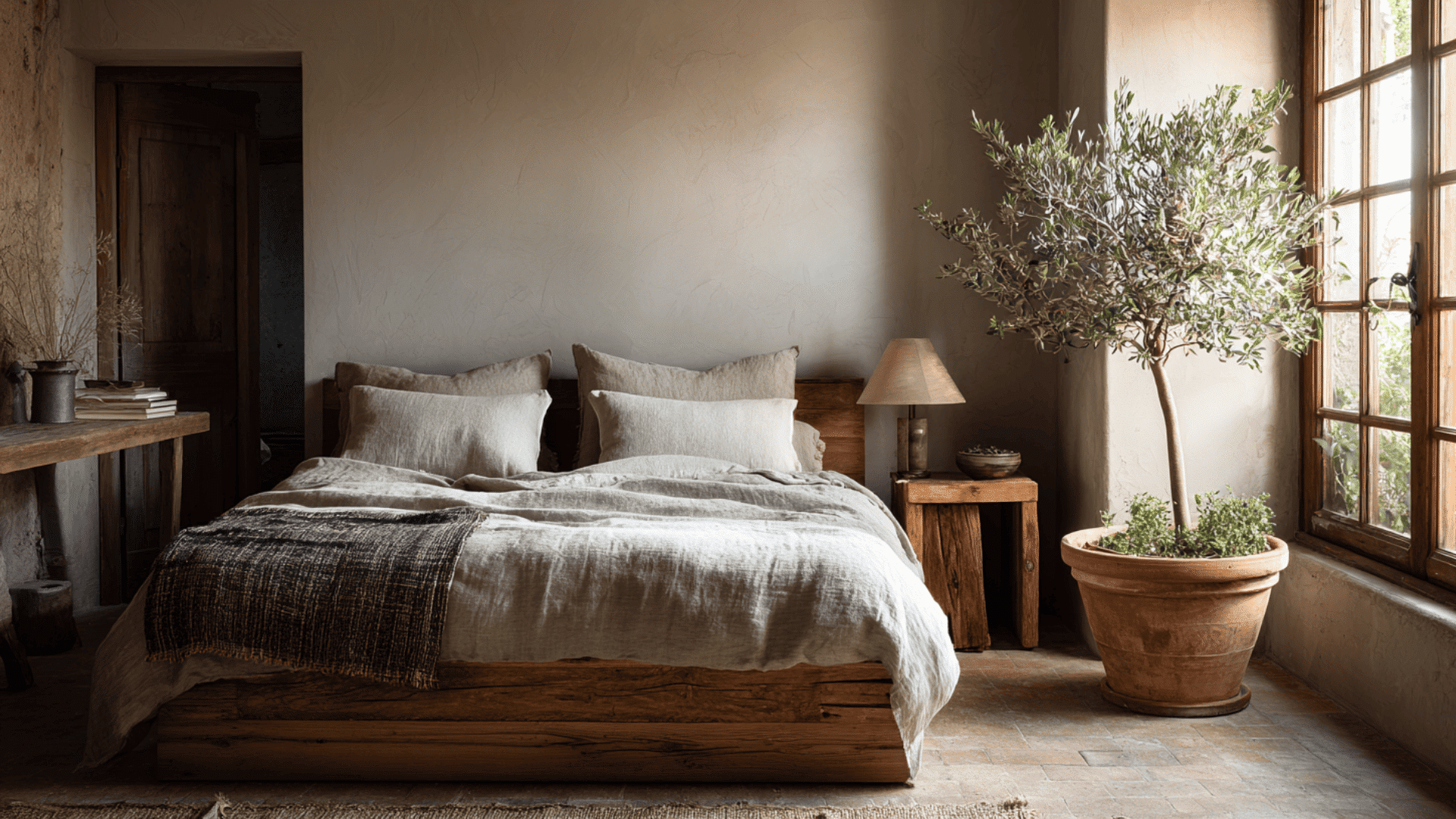
In a Tuscan-style bedroom, comfort comes first. I usually start with a solid wood bed frame, something that feels strong and grounded. Then I layer on soft linens, textured throws, and maybe place an old trunk at the foot of the bed.
You want the space to feel peaceful, but with a hint of romance. A few candle holders or a vintage-style lamp can really help set that mood.
Dining and Outdoor Spaces
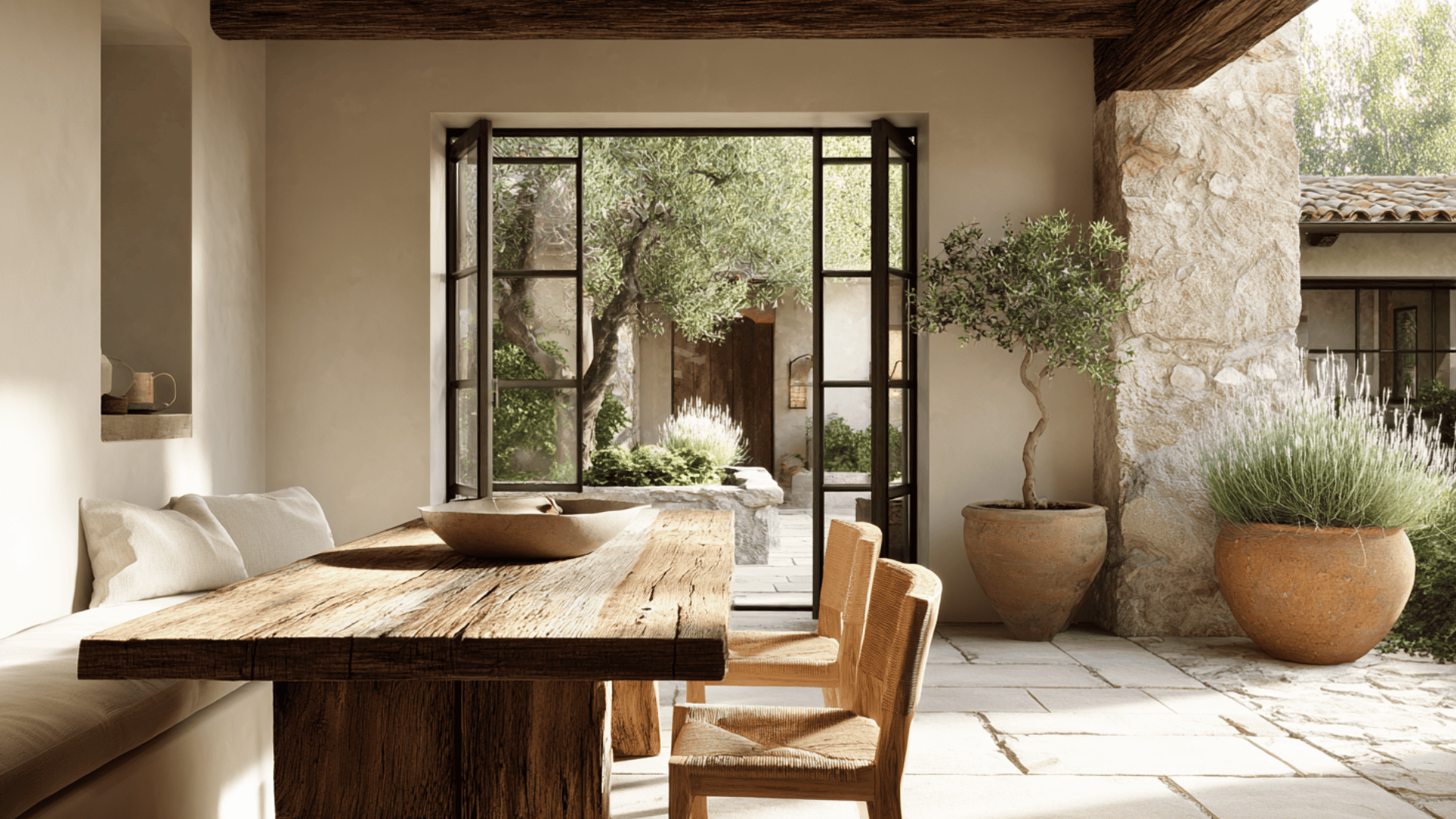
Tuscan dining rooms are made for slow, cozy meals. A big wooden table, simple chairs, and warm lighting set the tone. I like using long table runners and ceramic serving pieces to keep it casual.
If you’ve got an outdoor spot, that’s a great place to carry the look. Clay pots, stone pavers, and a few lanterns or string lights can turn even a small patio into a Tuscan-style courtyard.
Each room adds to the feel. And you don’t need to do it all at once. Even small elements can bring in that Tuscan warmth, one room at a time.
Bring the Tuscan Look Outdoors: Gardens Like Tuscany

Tuscan homes don’t stop at the walls; the outdoors plays just as big a role. If you enjoy gardening, this is the perfect place to bring the style to life.
Here’s how to create your own Tuscan-inspired garden or patio:
- Terracotta Planters Everywhere: Fill simple clay pots with rosemary, lavender, or olive trees. These hardy Mediterranean plants not only look great, they smell amazing and are easy to care for.
- Gravel Paths and Stone Borders: Skip the modern edging. Use loose gravel, worn pavers, or even broken terracotta tiles to get that relaxed, lived-in feel that Tuscan gardens are known for.
- Vines and Climbing Greenery: Grape vines, climbing roses, or jasmine trained over trellises or pergolas add soft shade and a romantic atmosphere.
- Outdoor Dining with Character: Set up a rustic wooden table with string lights and mismatched chairs. Add a ceramic pitcher filled with wildflowers, and you’ve got a perfect garden spot.
- Natural Colors and Simple Textures: Stick with warm, earthy tones and natural materials, weathered stone, aged wood, terracotta, and wrought iron. Even your garden tools or watering cans can mix right in.
If you have a full backyard or a small patio, you can echo the feeling of a Tuscan countryside with just a few well-chosen plants and textures.
It’s all about creating a space that feels grounded, lived-in, and connected to nature, just like the homes that inspired it.
Product & Shopping Guide
If you’re ready to bring Tuscan style into your home, shopping smart goes a long way. I’ve rounded up some favorite items and ideas that make it easier to get the look, without the stress or a big price tag.
These are the pieces I reach for when I want that warm, rustic vibe to really come through.
- Weathered wood furniture: Look for tables, dressers, or benches with a rough, aged finish.
- Wrought iron accents: Think candle holders, bed frames, light fixtures, or even wall art.
- Stone or terracotta decor: Planters, bowls, or tiles made from natural materials add earthy texture.
- Linen and cotton textiles: Choose throw pillows, table runners, or curtains in soft, washed fabrics.
- Vintage or antique pieces: Hit local markets or online shops for one-of-a-kind finds with history.
- Clay pottery and ceramics: Handmade or imperfect pieces give your home that real Tuscan charm.
- Muted, earthy artwork: Landscape prints, botanical sketches, or hand-painted tiles can tie it all together.
You don’t need to grab everything at once. Start with one or two standout pieces and build from there. That’s how I’ve always done it, and it tends to feel more natural that way.
Modern Tuscan Makeover
A lot of folks ask if Tuscan style feels outdated. I get it, the dark colors and heavy furniture from the early 2000s can seem like a bit much now. But with a few updates, you can give it a lighter, more modern feel.
No need to start from scratch. Just freshen up what you’ve got and let the space breathe.
Lightening the Look
One of the simplest ways to modernize Tuscan interiors is by softening the color palette. Swap out deep reds and browns for warm whites, creamy beige, or pale olive.
I’ve brightened up a living room just by repainting the walls and swapping out dark curtains; it made a big difference.
If your kitchen feels too heavy, take down a few upper cabinets and add open shelves. Even a lighter tile backsplash can lift the space and make it feel fresh again.
Mixing Styles
I’ve also found that Tuscan style works well with other looks. Try mixing rustic furniture with modern lighting or cleaner lines.
You can keep the wood beams and stone floors, but ease things up with simple fabrics or updated hardware. The trick is balance, letting old and new work together.
One client I worked with kept their original Tuscan fireplace but swapped out the heavy furniture for a sleeker sofa and a natural fiber rug. It still felt warm and rustic, just not weighed down.
Keeping the Soul
At the heart of Tuscan design is comfort and age. You don’t want to lose that by going too modern.
What works best, in my experience, is keeping a few raw, natural pieces, like a weathered dining table or a stone wall, and letting those stand out against cleaner, updated surroundings. It’s not about wiping out the past. It’s about letting it breathe.
If your home already has Tuscan features, don’t toss them. With a little editing, you can refresh the space and still hold onto what makes it feel special.
Styling Tips from Designers
You don’t need a full remodel to bring Tuscan style into your home. Over time, I’ve picked up a few simple designer tips that really help tie everything together, even when you’re just working with what you already have.
Easy Changes That Create Big Impact
Sometimes it’s the smallest details that change how a room feels. I’ve made a few of these updates myself, and they always give the space more warmth and charm.
- Textured fabrics: Swap out flat or shiny materials for linen, cotton, or woven blankets.
- Wrought iron accents: Try a new curtain rod, wall sconce, or cabinet handle in aged iron.
- Rustic furniture finishes: Lightly distressed wood or natural grains add depth and character.
- Layered decor: Group candles, books, or ceramic bowls on a table to build a cozy look.
- Smaller seating zones: Pull chairs and sofas closer together to make the room feel inviting.
Even one or two of these changes can shift the energy in a room and make it feel more like Tuscany.
Paint Guides, Fixture Swaps, and Budget-Friendly Upgrades
Paint and lighting can completely shift the feel of a room. I’ve found these updates to be low-cost but high-impact, especially when you’re aiming for a lighter, more updated Tuscan look.
- Warm neutral paints: Go for creamy whites, soft olive, golden beige, or light terracotta.
- Updated light fixtures: Choose iron, bronze, or wood. Skip anything shiny or modern.
- Secondhand statement pieces: Check antique shops for mirrors, lamps, or side tables.
- Ceramic and clay elements: Vases, bowls, and planters bring in an earthy, handmade vibe.
- Simple backsplash changes: Peel-and-stick stone or tile can quickly refresh a kitchen or bath.
These small changes can help you refresh without losing the charm of the original design.
Mistakes to Avoid
Designers agree that even good style can go wrong when it’s taken too far. I’ve made a couple of these mistakes myself and learned the hard way.
- Too much darkness: Overusing dark woods and deep colors can make rooms feel heavy.
- Mixing too many styles: Avoid combining modern or glam elements that don’t fit the rustic tone.
- Oversized furniture in tight spaces: Tuscan pieces can be large, just make sure they fit your room.
- Skipping texture: Without layers and rough finishes, Tuscan style can fall flat or feel too clean.
- Ignoring the lighting: Harsh, bright lighting takes away from the cozy, grounded atmosphere.
If you avoid these common issues, your home will feel more balanced, natural, and welcoming.
Tuscan style doesn’t have to be all or nothing. With just a few thoughtful updates, you can shape a space that feels relaxed, rustic, and totally yours.
Plant-Filled Tuscan House Interior Ideas
I’ve put together a few simple scenes that capture the heart of Tuscan style, nothing overdone, just warm, lived-in, and rooted in natural beauty.
These snapshots are easy to recreate and give your space a look that feels real and inviting.
1. A Sun-Drenched Dining Nook
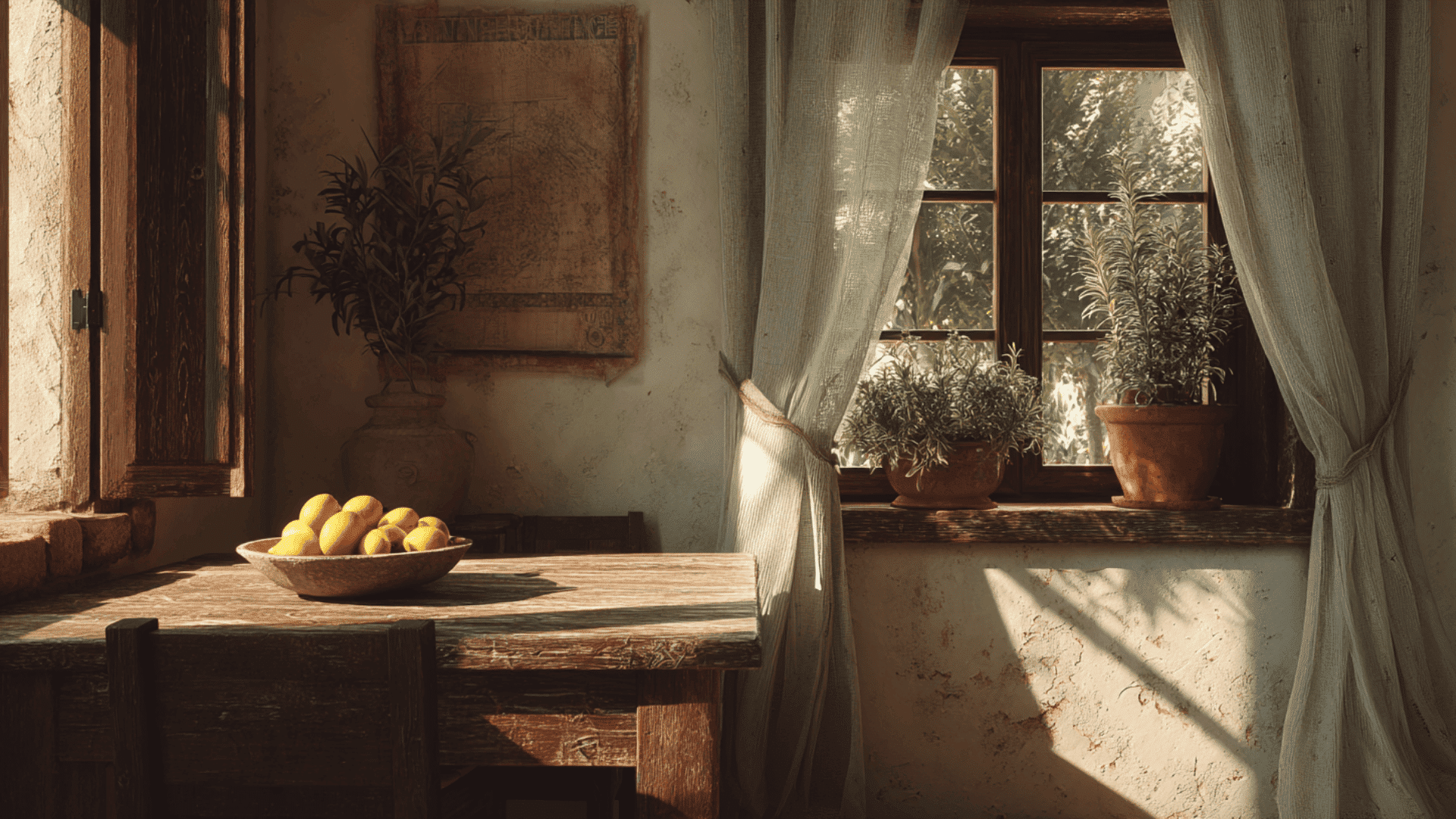
Picture a rustic wood table set beside a big window, with sunlight pouring across a bowl of lemons. Add linen curtains and a soft wall color, something like warm white or pale peach.
For some greenery, place a small terracotta pot of rosemary or thyme on the table. Fresh herbs not only look great, but you can snip them for cooking, too.
2. Cozy Living Room with Stone Fireplace
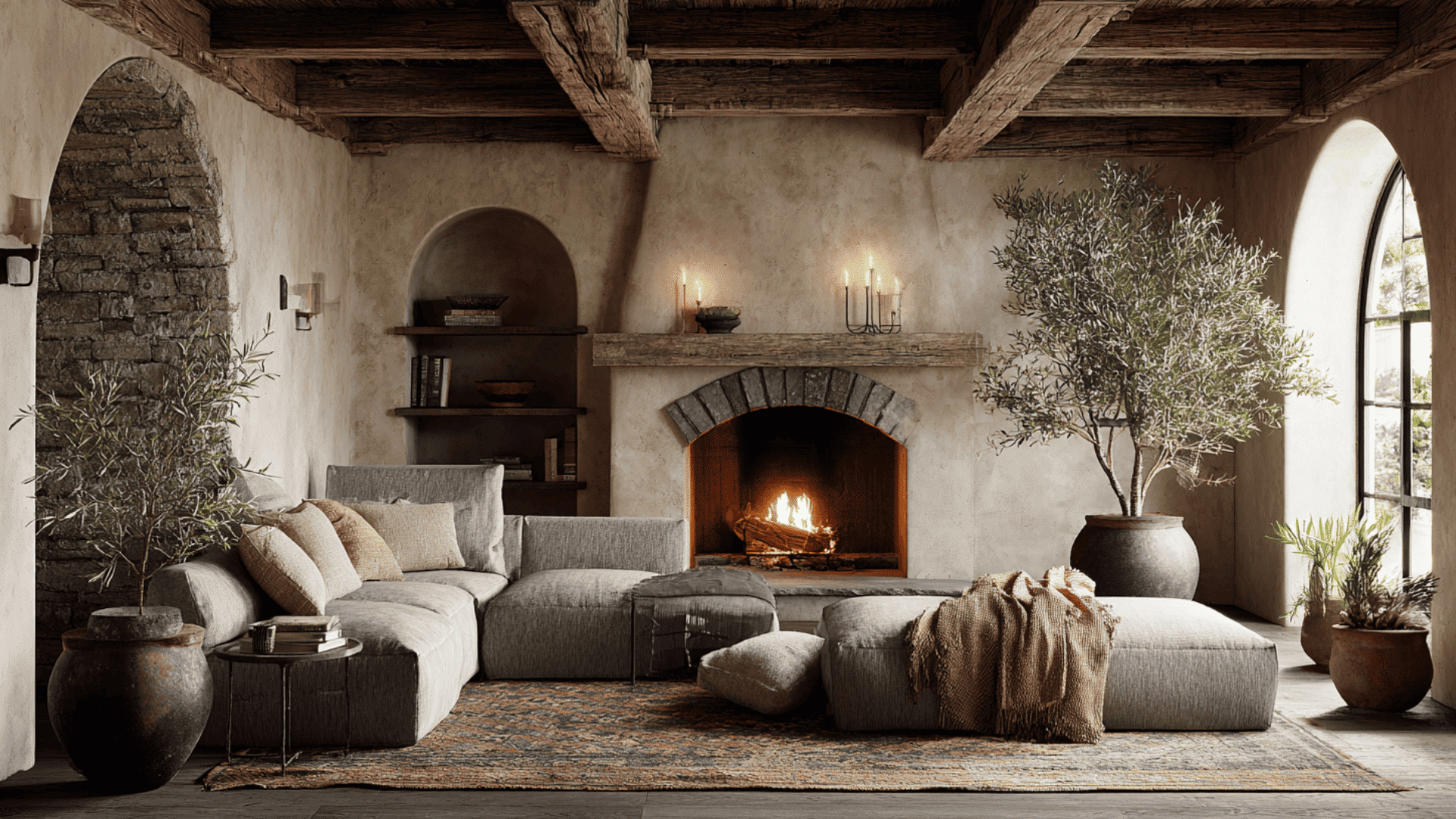
This space leans into texture. Think a weathered stone fireplace, exposed wood beams, and a deep, low sofa covered in textured throws. A faded rug and an iron floor lamp finish the look.
Add a few indoor plants like olive trees or trailing pothos in aged clay pots to echo that natural, grounded feel.
3. Kitchen with Open Shelves and Copper Pots
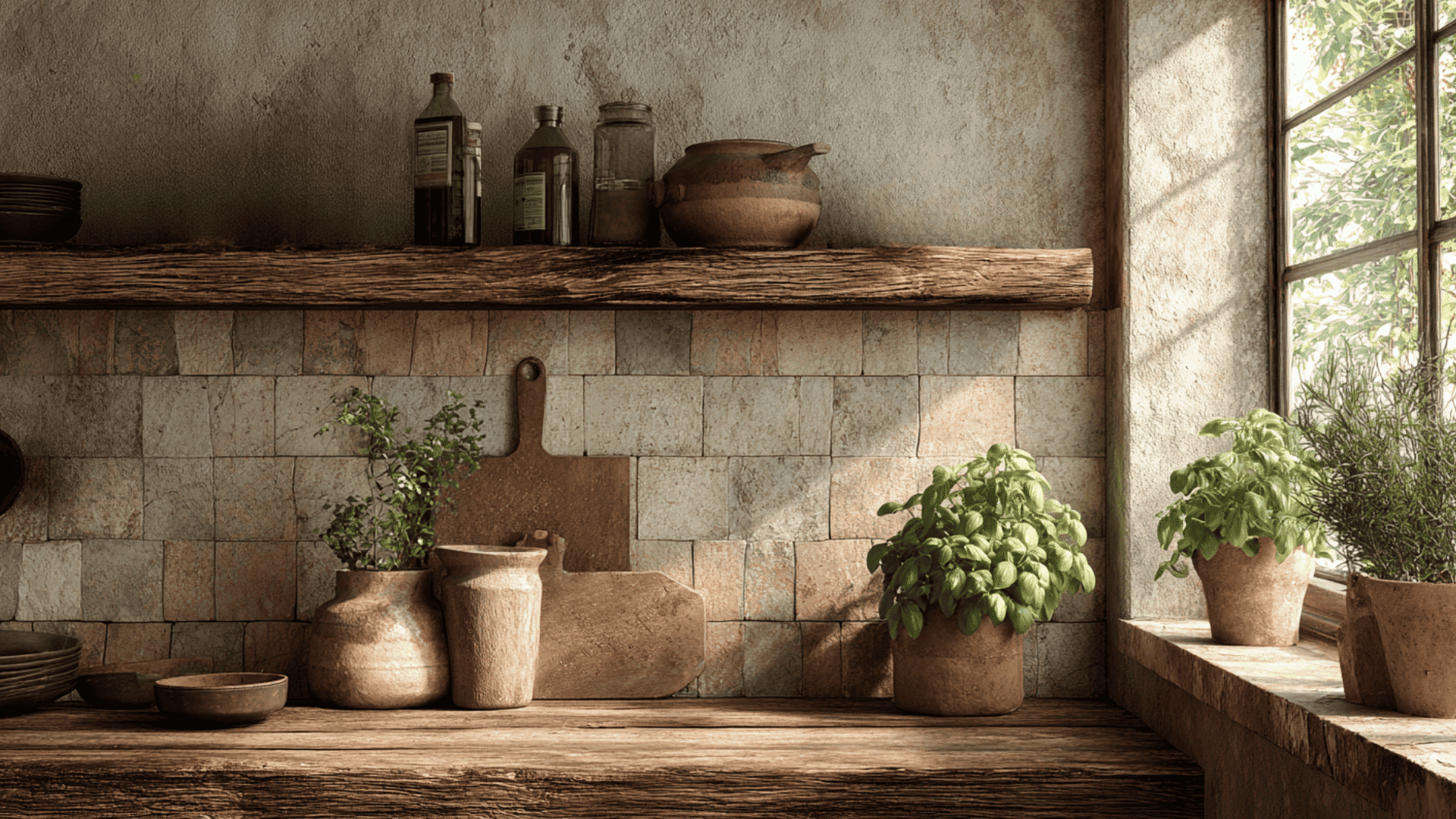
Skip the upper cabinets. Go for wooden shelves filled with ceramics and glass jars. Hang a few copper pots on the wall and use a rough tile backsplash. Keep the colors soft and earthy.
Line your windowsill with small basil or oregano plants in terra cotta planters. They’re useful and help keep the kitchen smelling fresh.
4. Earthy Bathroom Retreat
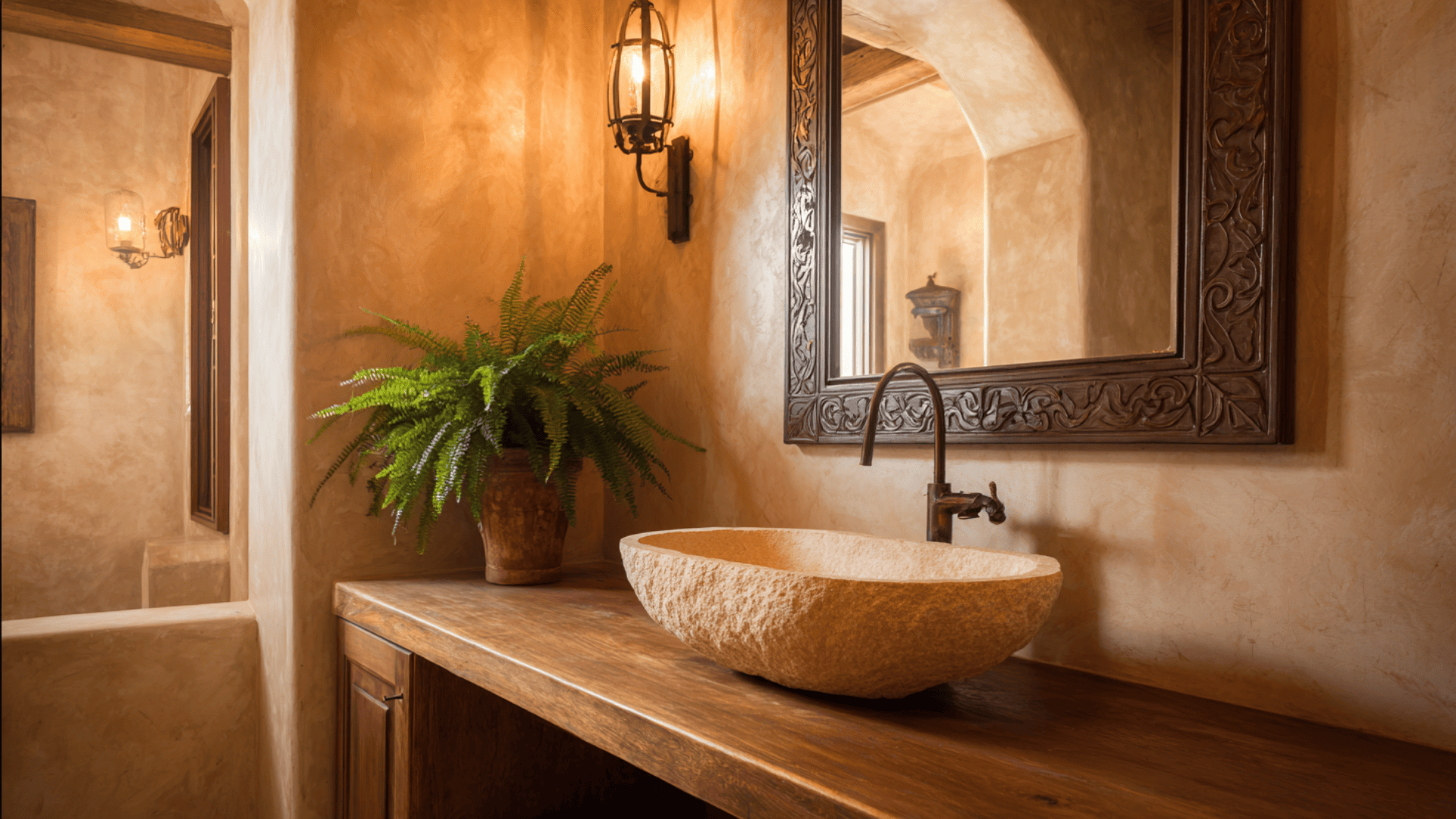
Start with a stone sink on a wooden vanity, warm beige walls, and a woven basket in the corner. A wrought iron mirror and soft lighting bring the whole space together. Add a potted peace lily or small fern on the vanity or near the tub for softness and a breath of greenery.
5. Courtyard-Style Patio
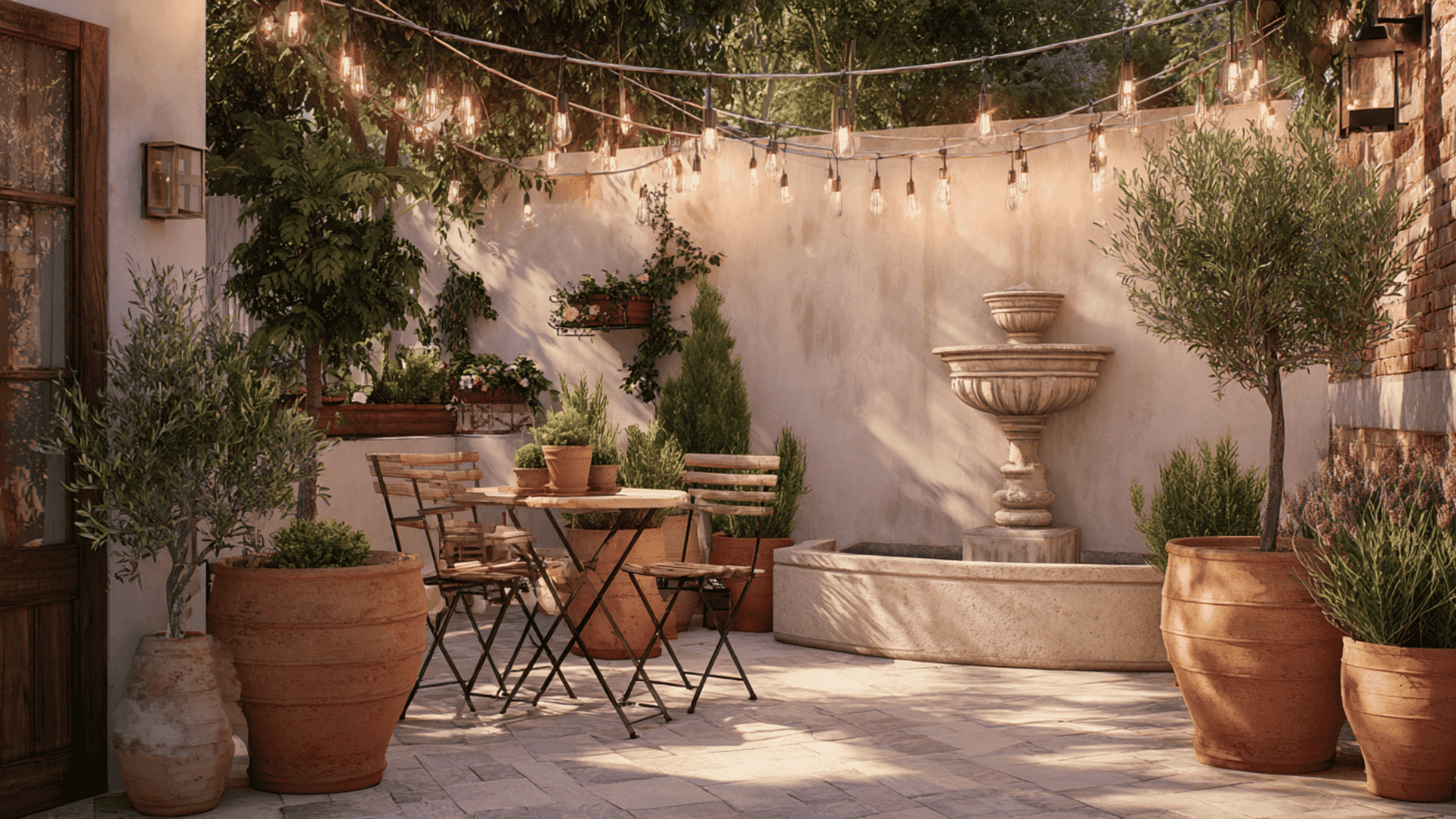
This one’s small but attractive, with terracotta pots, a little bistro table, and string lights overhead. Add a clay fountain or a few herb plants nearby.
Use lavender, sage, or even dwarf olive trees in planters to tie it all together and give the space that true Tuscan garden feel.
Each of these scenes combines rustic decor with natural greenery. Whether it’s a leafy plant by the fireplace or fresh herbs by the window, these elements help bring Tuscan warmth to life, one room (or pot) at a time.
Wrapping Up
A Tuscan house interior is rooted in warmth, comfort, and natural beauty. Trends do not drive it; it’s about making your space feel lived-in and welcoming.
You don’t need a full remodel to get there. Just a few thoughtful elements, soft colors, rustic wood, or simple iron accents can shift the feel of a room.
Start small. One corner, one wall, one piece of furniture. Let the look build over time.
Looking for more ideas to create cozy, character-filled spaces? Take a look at my other posts on rustic kitchens, old-world bathrooms, and European-inspired home styles.


